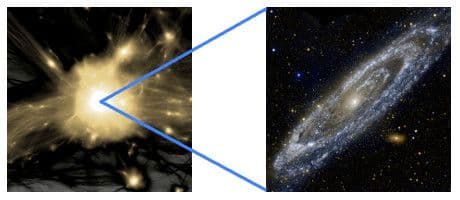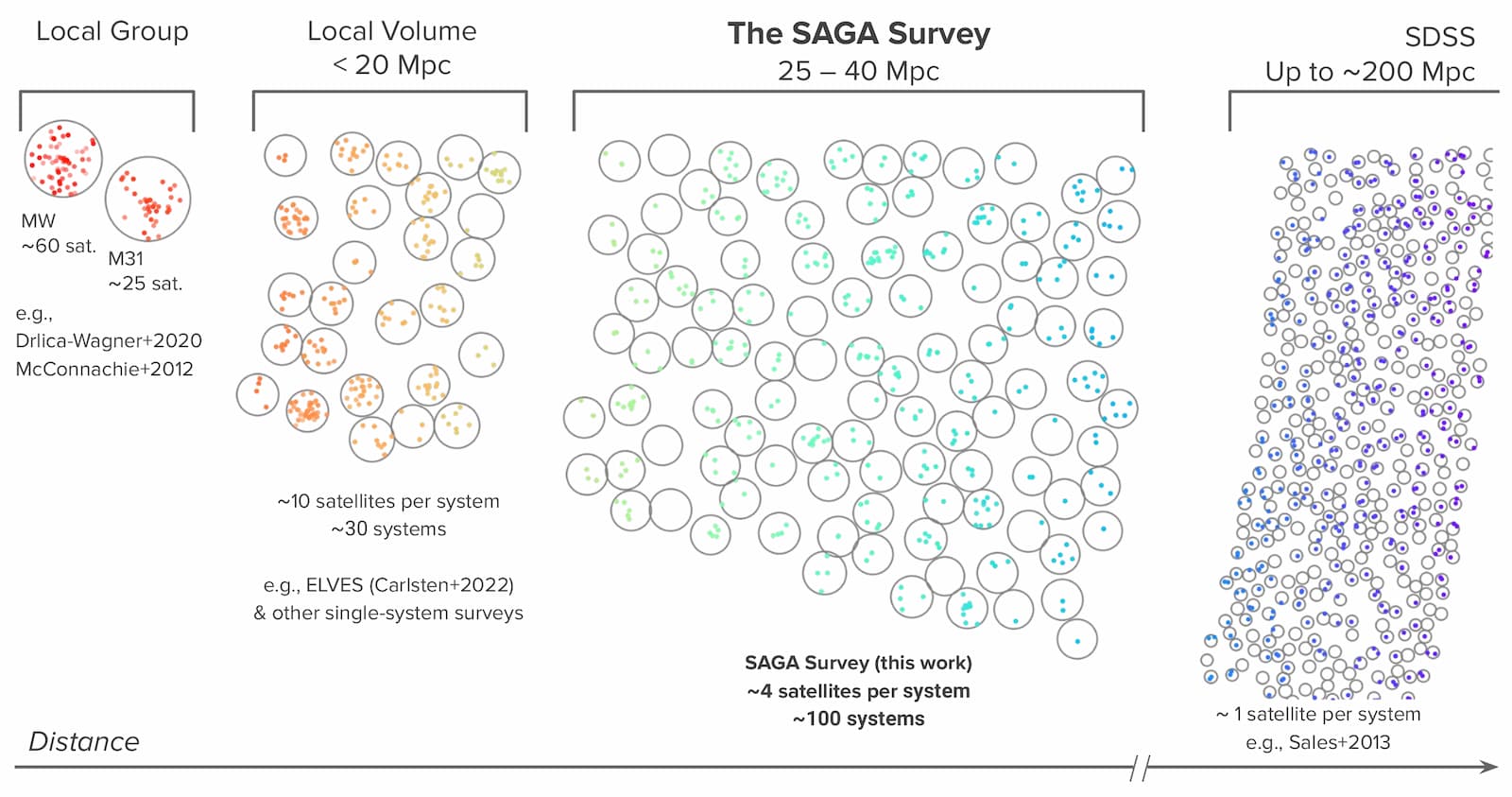Research
🆕 SAGA Survey DR3 papers [III, IV, V], posters [III, IV, V], data, and press article.
My research focuses on the nature of dark matter, galaxy formation physics, and the uniqueness of our own Milky Way. In particular, I use astronomical surveys and numerical simulations to study low-mass galaxies in the nearby Universe, modeling the relation between these galaxies and their host dark matter halos to learn about the underlying dark structures.

Below I detail the areas of my research interest, with links to selected papers.
I also list the science collaborations that I have participated in and my contributions.
You can also check out my Curriculum Vitae (CV) ![]() , and a list of my publications.
, and a list of my publications.
Areas of Interest
- Satellite galaxies in Milky Way-like systems:
to explore the abundance and properties of the satellite galaxies in the Milky Way [ref:1,2] and beyond [ref:1,2,3,4],
and to compare them with theoretical predictions [ref:1,2,3,4,5,6,7,8,9].

- Low-mass galaxies in the nearby Universe: to use novel method to search for very low-redshift (z < 0.05) low-mass galaxies [ref:1,2,3], for and ultra-faint galaxies right outside of the Milky Way[1,2], as these faint low-mass galaxies hold key information about galaxy formation and dark matter properties.
- Halo and galaxy assembly/secondary biases: to understand how halo clustering [ref:1,2] and galaxy clustering [ref:1,2,3,4,5] depend on halo formation histories and other secondary properties; to identify novel probes to constrain assembly bias [ref,ref].
- Dark matter substructures and halo structure: to explore how dark matter substructures affect their host halo structure [ref:1,2], and what properties of the host halos affect the abundance of dark substructures [ref:1,2,3,4], and to provide predictions for observations of dark substructures, for the various dark matter models [ref:1,2,3].
- Galaxy dynamics at small scales: to predict small-scale galaxy properties/dynamics using gravity-only simulations and galaxy-halo connection models and compare with observation [ref:1,2].
- Zoom-in dark matter simulations: to better understand the variance in various halo properties by analyzing a statistical sample of zoom-in isolated halos in LCDM [ref:1,2,3,4] and also for SIDM [ref]
- Local velocity distribution function (VDF) of dark matter: to find an accurate VDF model [ref], which is crucial to dark matter direct detection experiments, especially for low-mass dark matter candidates [ref].
Collaborations
I participate in many collaborative projects, including:
- Satellites Around Galactic Analogs (SAGA): A spectroscopic survey that searches for low-mass galaxies around nearby Milky Way-like galaxies to obtain satellite luminosity functions of these systems, which enable us to learn more about the nature of dark matter and galaxy formation physics [ref:1,2,3,4,5].
- Rubin Observatory LSST Dark Energy Science Collaboration (DESC): I am currently a Dark Matter Working Group co-convener, and was a Data Access Team co-lead. I contribute to the validation and data access effort for the DESC Data Challenge 2 (DC2), including the cosmoDC2 synthetic galaxy catalog and the simulated sky survey. Selected DC2 data sets are publicly available at the DESC Data Portal, which I help develop. I led the development of the DESCQA validaton framework [ref] and the Generic Catalog Reader that provides an unifed data access interface. I helped form the Dark Matter Working Group in the DESC in 2019. I was credited the Builder Status by the DESC in 2019.
- Rubin Observatory LSST Dark Matter Group: a community effort to explore how observations from the LSST can act as novel probes to provide constraints on the fundamental nature of dark matter [ref]. As of 2020, most activities have been taking place in the Dark Matter Working Group in the DESC.
- Southern Stellar Stream Spectroscopic Survey (S5): A spectroscopic survey that maps the kinematics and chemistry of stellar streams in the Southern Hemisphere. I coordinate an auxiliary science case on finding low-redshift galaxies [ref].
- DECam Local Volume Exploration Survey (DELVE): a survey program to study low-mass galaxies in the Local Volume by imaging the entire southern sky with DECam [ref].
- Magellanic Satellites Survey (MagLiteS): a NOAO community survey that uses DECam to explore the neighborhood of the Magellanic system [ref].
- Dark Energy Survey (DES): In 2015, I helped analyzing the anisotopic spacial distribution of the newly discovered Milky Way satellite candidates [ref]. More recently, as an external collaborator, I participated in the theoretical analysis of all Milky Way satellites discovered to date [ref].
- Dark Energy Spectroscopic Instrument (DESI): In 2019 I participated in a study of DESI-like LRG clustering [ref]. And, while not as part of a DESI project, I developed the DECaLS Image List Tool to display image cutouts retrieved from the Dark Energy Camera Legacy Surveys.
- The Aemulus Project: A set of simulations to builds emulators for precision cosmology [ref:1,2,3].
- Sussing Merger Trees: a series of comparison among different merger tree building codes [ref].
Media Highlights
- Astronomers celebrate images decades in the making [U of Utah, 2025/07]
- How Weird is the Milky Way? (cover story featuring the SAGA Survey) [Astronomy Magazine, 2025/07]
- The 4 biggest mysteries the new Vera Rubin Observatory could solve [National Geographic, 2025/06]
- 'Vast discovery' of black holes in dwarf galaxies [U of Utah, 2025/02]
- The Milky Way represents an outlier among similar galaxies, universe survey data shows [Stanford, 2024/11]
- How special is the Milky Way Galaxy? [U of Utah, 2024/09]
- The SAGA saga: Putting the Milky Way's 'peculiarities' into context [Yale News, 2024/09]
- The curious case of the dwarf galaxy Pegasus W [astrobites, 2023/01]
- An Unusual Home (featuring the SAGA Survey) [Sky & Telescope, 2022/04]
- Queer Astronomy, Part 2: Building a more inclusive community [astrobite, 2021/07]
- One Dark Matter Profile Please, Hold the Subhaloes [astrobites, 2020/07]
- The Milky Way’s satellites help reveal link between dark matter halos and galaxy formation [SLAC News, 2020/03]
- Is the Milky Way an 'outlier' galaxy? Studying its 'siblings' for clues [Yale News, 2017/09]
- Standard Model of the Universe Withstands Most Precise Test by Dark Energy Survey [SLAC News 2017/08]
- Building Halos by Digesting Satellites [AAS NOVA, 2016/05]
- Stanford physicists help discover hidden dwarf dark galaxy [Stanford News, 2016/04]
- Learning about the future from the distant past [Stanford News, 2016/03]
- Dark Energy Survey finds more celestial neighbors [Fermilab News, 2015/08]
- Scientists find rare dwarf satellite galaxy candidates in Dark Energy Survey data [Fermilab News, 2015/03]
- KIPAC Theorists Weigh In on Where to Hunt Dark Matter [SLAC News, 2013/05]
- Hints of lightweight dark matter get even stronger [New Scientist, 2013/05]
- Learning to play the dark matter boogie [Symmetry Magazine, 2012/10]